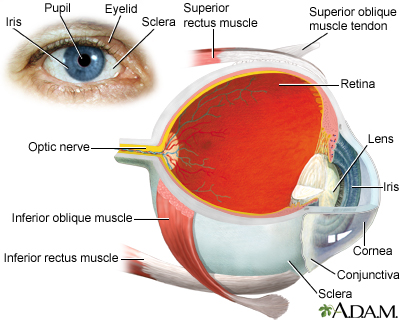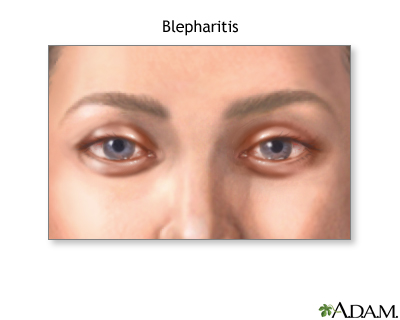Health Library
Blepharitis
Eyelid inflammation; Meibomian gland dysfunction
Blepharitis is manifest by inflamed, irritated, itchy, and reddened eyelids. It most often occurs where the eyelashes grow. Dandruff-like debris builds up at the base of the eyelashes as well.
Images


I Would Like to Learn About:
Causes
The exact cause of blepharitis is unknown. It is thought to be due to:
- An overgrowth of bacteria.
- A skin mite called Demodex.
- A decrease or breakdown of the normal oils produced by the eyelid.
Blepharitis is more likely to be seen in people with:
- A skin condition called seborrheic dermatitis or seborrhea. This problem involves the scalp, eyebrows, eyelids, skin behind the ears, and the creases of the nose.
- Allergies that affect the eyelashes (less common).
- Excess growth of the bacteria that are normally found on the skin.
- Rosacea, which is a skin condition that causes a red rash on the face.
Symptoms
Symptoms include:
- Red, irritated eyelids
- Scales that stick to the base of the eyelashes
- Burning feeling in the eyelids
- Crusting, itching and swelling of the eyelids
You may feel like you have sand or dust in your eye when you blink. Sometimes, the eyelashes may fall out. The eyelids may become scarred if the condition continues long-term.
Exams and Tests
The health care provider can most often make the diagnosis by looking at the eyelids during an eye exam. Special photos of the glands that produce oil for the eyelids can be taken to see if they are healthy or not.
Treatment
Cleaning the edges of the eyelid every day will help remove excess bacteria and oil. Your provider might recommend using baby shampoo or special cleansers. Using an antibiotic ointment on the eyelid or taking antibiotic pills may help treat the problem. It may also help to take fish oil supplements.
If you have blepharitis:
- Apply warm compresses to your eyes for 5 minutes, at least 2 times per day.
- After the warm compresses, gently rub a solution of warm water and no-tears baby shampoo along your eyelid, where the lash meets the lid, using a cotton swab.
A device has recently been developed that can warm and massage the eyelids to increase the flow of oil from the glands. The role of this device in treatment of blepharitis remains unclear.
A drug containing hypochlorous acid, which is sprayed onto the eyelids is helpful in certain cases of blepharitis, especially when rosacea is also present.
If Demodex is suspected as the cause, tea tree oil applied to the lids by your provider can be helpful; a new prescription medicine may soon be available.
Outlook (Prognosis)
The outcome is most often good with treatment. You may need to keep the eyelid clean to prevent the problem from coming back. Continuing treatment will ease redness and help make your eyes more comfortable.
Styes and chalazia are more common in people with blepharitis.
When to Contact a Medical Professional
Contact your provider if symptoms get worse or do not improve after several days of carefully cleaning your eyelids.
Prevention
Cleaning the eyelids carefully will help reduce the chances of getting blepharitis. Treat skin conditions that may add to the problem.
Related Information
Seborrheic dermatitisAllergies
Body lice
Scales
Eyelid bump
Chalazion
Rosacea
Corneal ulcers and infections
Conjunctivitis or pink eye
References
Blackie CA, Coleman CA, Holland EJ. The sustained effect (12 months) of a single-dose vectored thermal pulsation procedure for meibomian gland dysfunction and evaporative dry eye. Clin Ophthalmol. 2016;10:1385-1396. PMID: 27555745 pubmed.ncbi.nlm.nih.gov/27555745/.
Cioffi GA, Liebmann JM. Diseases of the visual system. In: Goldman L, Schafer AI, eds. Goldman-Cecil Medicine. 26th ed. Philadelphia, PA: Elsevier; 2020:chap 395.
Isteitiya J, Gadaria-Rathod N, Fernandez KB, Asbell PA. Blepharitis. In: Yanoff M, Duker JS, eds. Ophthalmology. 5th ed. Philadelphia, PA: Elsevier; 2019:chap 4.4.
Kagkelaris KA, Makri OE, Georgakopoulos CD, Panayiotakopoulos GD. An eye for azithromycin: review of the literature. Ther Adv Ophthalmol. 2018;10:2515841418783622. PMID: 30083656 pubmed.ncbi.nlm.nih.gov/30083656/.
Shah PP, Stein RL, Perry HD. Update on the management of Demodex blepharitis. Cornea. 2022;41(8):934-939. PMID: 34743107 pubmed.ncbi.nlm.nih.gov/34743107/.
Trattler W, Karpecki P, Rapoport Y, et al. The prevalence of Demodex blepharitis in US eye care clinic patients as determined by collarettes: a pathognomonic sign. Clin Ophthalmol. 2022;16:1153-1164. PMID: 35449733 pubmed.ncbi.nlm.nih.gov/35449733/.
BACK TO TOPReview Date: 8/22/2022
Reviewed By: Franklin W. Lusby, MD, Ophthalmologist, Lusby Vision Institute, La Jolla, CA. Also reviewed by David C. Dugdale, MD, Medical Director, Brenda Conaway, Editorial Director, and the A.D.A.M. Editorial team.
 | A.D.A.M., Inc. is accredited by URAC, for Health Content Provider (www.urac.org). URAC's accreditation program is an independent audit to verify that A.D.A.M. follows rigorous standards of quality and accountability. A.D.A.M. is among the first to achieve this important distinction for online health information and services. Learn more about A.D.A.M.'s editorial policy, editorial process and privacy policy. A.D.A.M. is also a founding member of Hi-Ethics. This site complies with the HONcode standard for trustworthy health information: verify here. |
The information provided herein should not be used during any medical emergency or for the diagnosis or treatment of any medical condition. A licensed medical professional should be consulted for diagnosis and treatment of any and all medical conditions. Links to other sites are provided for information only -- they do not constitute endorsements of those other sites. © 1997- 2023 A.D.A.M., a business unit of Ebix, Inc. Any duplication or distribution of the information contained herein is strictly prohibited.
